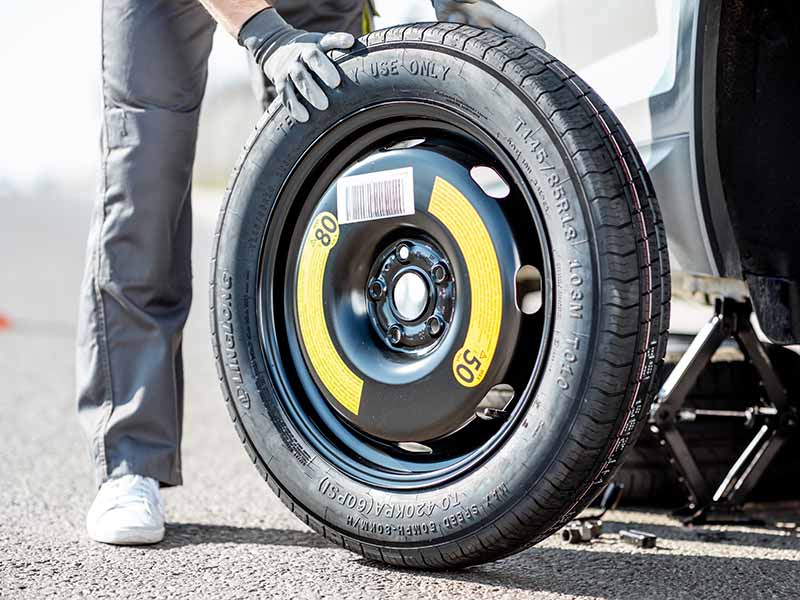These days you can’t count of having a spare tire included with your car or truck. Many vehicles will only come with an inflation kit with a tire sealant or possibly run flat tires.
Each of these alternatives have their downsides. Having an actual spare tire has become a bit of a luxury.
If you’re lucky enough to have a spare, you should make sure that you perform regular tire maintenance and make sure it is up to the task if the need arises.
In this article we’ll cover the different types of spare tires so you’re prepared for the unique issues they each present, and how to make sure they’re ready to be used if you ever need to use one.
Spare Tire Maintenance
• Familiarize yourself with the type of spare tire you have
• Ensure your spare is properly inflated
• Inspect the spare for damage
• Make sure you have the tools required to change a tire with your specific type of spare
• Be sure you have unusual tools like wheel lock keys or inflators for collapsible spares
Types Of Spare Tires
There are actually several different types of spare tires. The maintenance and things to check will vary slightly depending on what type of spare tire you have.
Let’s go over each of the different types of spare tire.
Full Size Matching Spare Tire
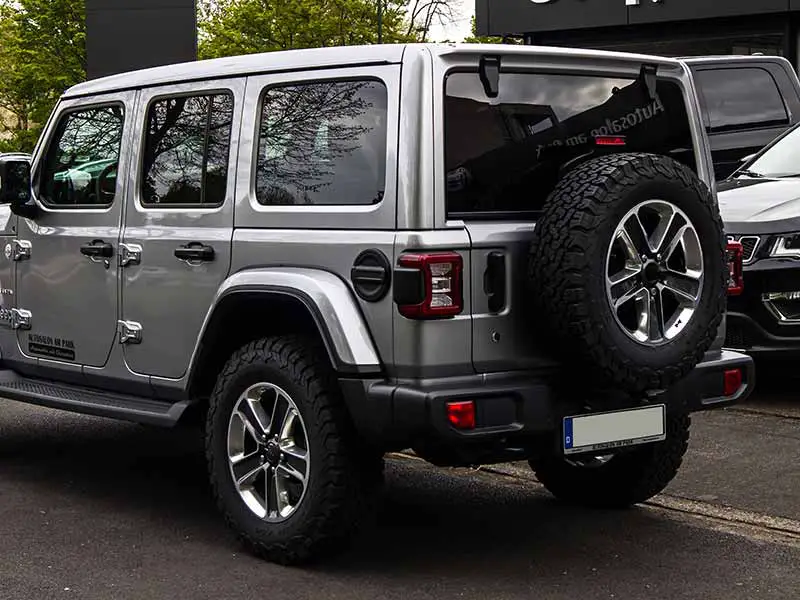
Full size matching spare tires are great for the few vehicles that happen to have one. Usually larger vehicles and ones that see more off-road use. Jeeps commonly have a full size matching spare tire for instance.
A full size matching spare tire means that the tire is the same brand, model, and size of the other tires on your car or truck. Also, the wheel is the same as the other four wheels. This means that you can replace a flat tire and not need to worry about dealing with replacing it until it’s convenient for you to do so.
Full size matching spares should be included when your tires are rotated. By keeping your full size spare in rotation, you extend the life of your full set of tires.
Be sure and check out some of our tire rotation articles discussing 5 tire rotation patterns.
Also, having the spare regularly in use you really don’t need to periodically check to see if it is in good condition. Since it is periodically in use, you can usually be assured that it’ll be ready to go when you need it.
Advantages
- Can be used when rotating your tires to extend the overall life of the set
- Will look, feel, and act the same as the other four tires
- Will get you home safely
- Doesn’t require special attention if included in regular rotation
Disadvantages
- Takes up a lot of space and adds extra weight
Full Size Non-Matching Spare Tire
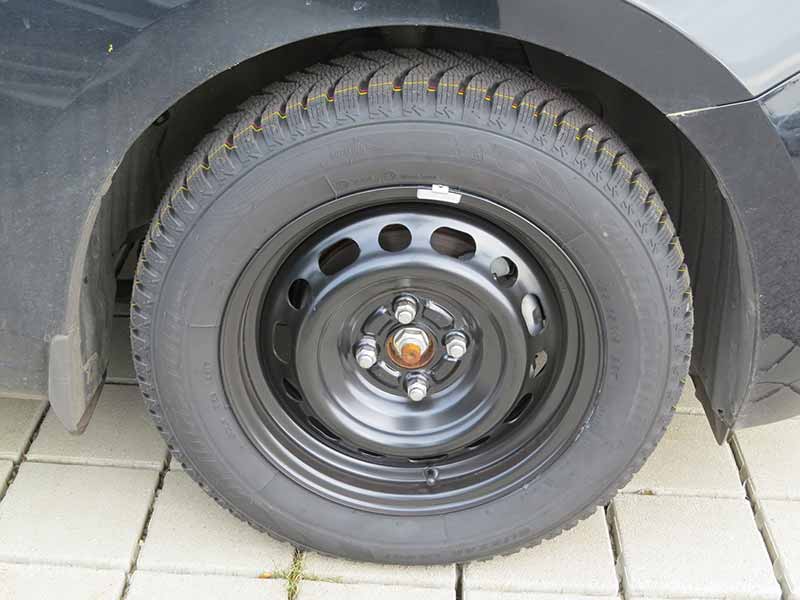
Full size non-matching spares may have the same tire that’s on all the other tires, or it may have one that is completely different. What’s more often meant by non-matching though is that the wheel the tire is mounted on is an economy rim that is usually a basic steel wheel.
Full size non-matching spares won’t be used for rotations because they’ll look out of place compared to the nicer wheels on the other corners of the vehicle.
The downside of this type of spare tire is that you don’t gain any benefits in exchange for the advantages of matching spare tires you loose.
Advantages
- Will usually feel and act the same as the other four tires unless the tire is significantly different somehow.
- Will get you home safely
Disadvantages
- Will not be included in regular tire rotation
- Will need to be periodically checked to ensure it holds pressure and has no damage
- Takes up a lot of space and adds extra weight
Full Size Temporary Spare Tire
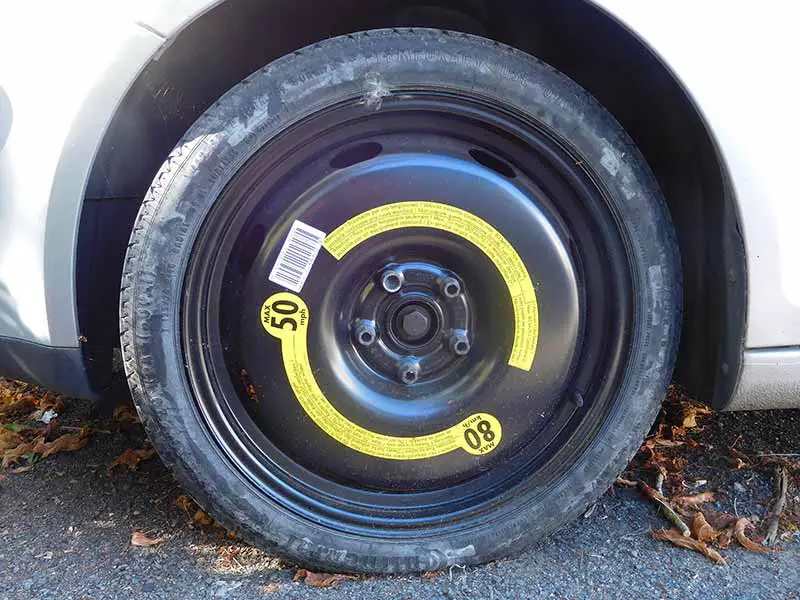
Full size temporary spares will have the same vertical dimensions as the other tires, but the width is usually much narrower. Temporary tires are exactly as the name implies, temporary.
Tread on temporary tires is usually minimal and not meant for extended use. Most temporary tires are not meant to be driven on for more than 50-70 miles. They also are unsafe to be used at high speeds.
When switching out a tire from a normal passenger vehicle tire to a temporary tire you may begin to experience issues with anti-lock brakes and traction control. This is less of a problem with full sized tires but the smaller contact patch and more shallow tread depth of a temporary tire will have much less traction and will cause these systems to behave accordingly.
Full size spares take up a little less space and weigh a little less than full size matching and non-matching spares. But you give up even more advantages in exchange for very little extra space and weight savings.
Advantages
- Will get you home safely
Disadvantages
- Range is limited to 50-70 miles
- Highway speeds are prohibited
- Will have reduced traction that can affect antilock braking and traction control
- Will not be included in regular tire rotation
- Will need to be periodically checked to ensure it holds pressure and has no damage
- Takes up a lot of space and adds extra weight
Compact Temporary Spare Tire
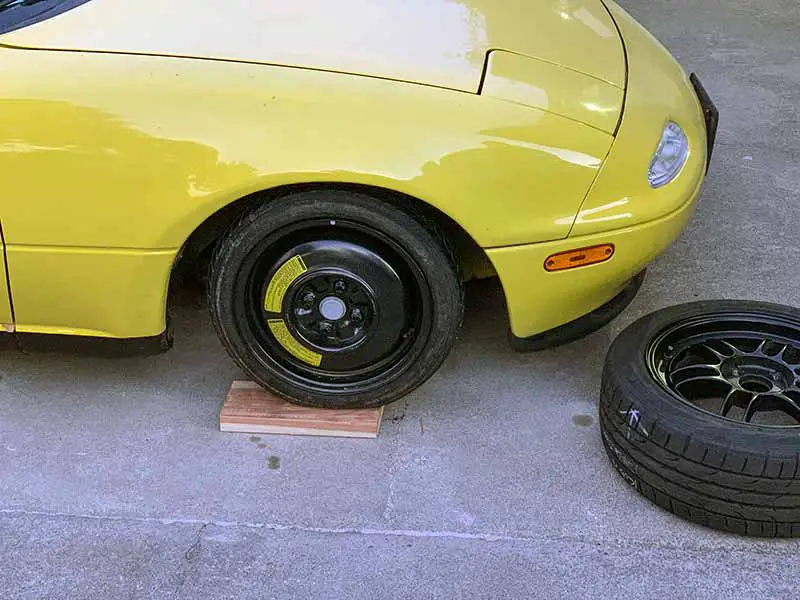
They have a smaller wheel and a temporary tire but they will still work. They are much smaller than the normal wheel and tire but still fit and do the job.
Compact spares try to tackle the main problem experienced with full size spare tires, which is the large amount of space and weight they require.
These spare tires are much more popular for use in smaller cars than larger trucks and SUVs.
Advantages
- Will get you home safely
- Takes up less space than full sized spares
Disadvantages
- Range is limited to 50-70 miles
- Highway speeds are prohibited
- Will have reduced traction that can affect antilock braking and traction control
- Will not be included in regular tire rotation
- Will need to be periodically checked to ensure it holds pressure and has no damage
Collapsible Temporary Spare Tire
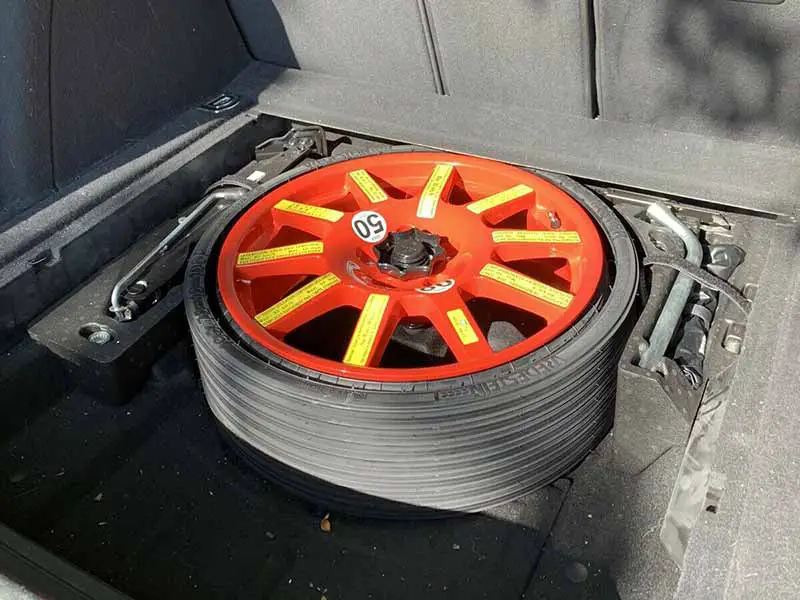
Collapsible spare tires are essentially spare tires that need to be inflated before use. The goal with these is to save even more space in vehicles which have very little room to accommodate a spare tire.
Unfortunately, these solutions require more equipment to ensure that you can get back on the road and home safely. You’ll either need an air compressor or a compressed air canister. These extra tools take up less volume than the inflated tire but add to the complexity when you’re stranded on the side of the road.
They also add more points of failure when ensuring you’re prepared when you experience a flat tire. The biggest point of failure is often the user unfortunately. Using some of these inflation systems may not be within the comfort zone of some people.
Canister inflation methods also don’t offer as much room for failure since there is a finite amount of compressed air available to inflate the spare.
The good news is that the spare will not need to be check to ensure it is properly inflated. You should read the instructions ahead of time however so that you are prepared in the event you need to use it. Being familiar with the process will make things much easier on the side of the road.
Advantages
- Will get you home safely
- Takes up less space than compact spares
Disadvantages
- Range is limited to 50-70 miles
- Highway speeds are prohibited
- Will have reduced traction that can affect antilock braking and traction control
- Will not be included in regular tire rotation
- Can be difficult to use
Spare Tire Pressure
Spare tire air pressure for full size non-temporary spare tires should match that listed on the sticker located in the driver’s door jam or owner’s manual. Normal passenger vehicle tires are typically inflated to around 35 psi.
Temporary spare tires, whether full-sized or smaller donut sized spares typically should be inflated to a much higher pressure. This pressure is usually 60 psi. Unlike normal tires, the pressure temporary tires should be inflated is listed on the sidewall of the tire itself.
How Long Does An Unused Spare Tire Last?
Most tires have a guaranteed lifespan of 6 years. Spare tires tend to last a little longer due to being kept out of direct sunlight, but 6 years is still a wise amount of time to have your spare tire replaced.
The rubber used in all tires reacts poorly with oxygen in the air. The oxygen slowly breaks down the rubber and will eventually cause it to begin drying out and cracking. Ozonate is an additive put into the rubber itself to help slow this process down, which is why tire manufacturers are able to extend the usable life of an unused tire to 6 years.
Can You Reuse A Spare Tire?
Spare tires can be reused several times. Hopefully you won’t have a need to use your spare several times though.
As long as the tire is holding pressure and there is no visible damage, it should be safe to drive on.
Can Spare Tires Be Repaired?
If you somehow manage to get a flat with your spare tire, you won’t be able to get it patched. Spare tires don’t have the same structural strength that normal full size tires have and patching is much less effective so most companies will refuse to patch them for your protection and theirs.
Required Tools
As part of your spare tire maintenance, you should ensure that you have all of the tools necessary to change the tire. The tools required will vary from one vehicle to the next.
The most obvious tools that everyone will need are a lug wrench and jack. Some ones that you might not consider that will be important when you’re stranded on the side of the road are any wheel locks that may be used to prevent the theft of your wheels. Ensuring you have a way to inflate a collapsable tire is also important.
I personally make sure to carry a good quality tire inflator that I can plug into a 12-volt jack in my car. I consider this mandatory whether the spare is collapsible or not. I like the Craftsman V20 Inflator for the excellent quality, ease of use, and affordable price.
Resources
Below are some links you may find helpful when learning about tires
- How long do spare tires last? And other spare tire questions – AAA
- Common spare tire problems – Cars.com
Final Thoughts
Being prepared to deal with a flat tire can make the difference between a minor inconvenience and a serious or even dangerous situation. Having your spare’s tire pressure checked, ensuring you have all the tools you’ll need, and having a reliable tire inflator just in case, are all wise moves.
Hopefully you won’t need to use your car’s spare tire ever. But if you do, it’s better to be ready than stuck in an unpleasant situation.
